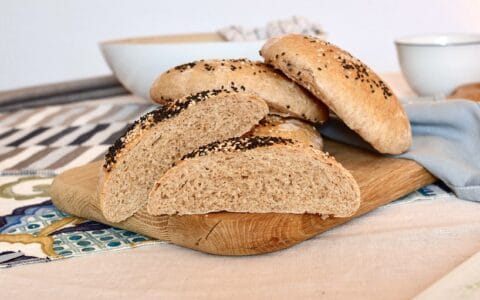If you are looking for the right bread to make kebap but cannot find any good store-bought flatbread, you are at the right place. This recipe is a whole-grain variant of the classic Turkish döner bread called pide.
This recipe yields either 4 individual bread rolls big enough for a doner kebab, as you see them in the photos. Alternatively, you can bring the dough into the classic flatbread shape. This page describes both ways.

Pide? Pita? Pitta?
You can find many similar bread types in the eastern Mediterranean and the middle east. While pita and pitta bread are flatter, the Turkish variant named pide is taller and fluffy on the inside.
Their basic concept is usually quite similar - It's a wheat dough made with fresh yeast, shaped into a flatbread, and baked or fried crispy. Pide stands out as it rises more and gets closer to "western style" bread, similar to baguettes. This allows the dough to be used versatilely in various shapes.
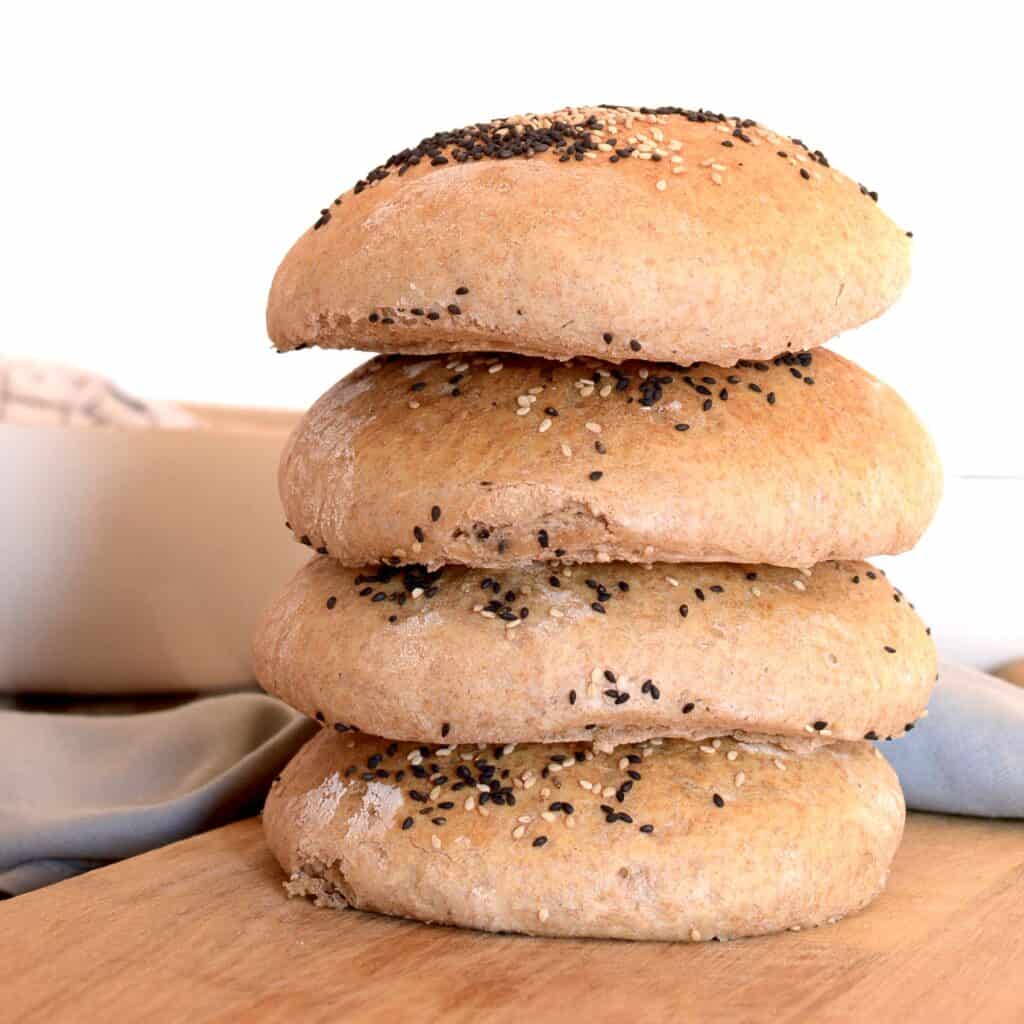
What to eat with döner bread?
These bread rolls are intended to follow their big brother, pide, which is a flatbread the size of a pizza. When sold as street food, this bread wheel is cut in four and then filled with meats, salads, and sauces. Sometimes, you encounter these smaller-sized döner bread rolls, where one roll makes one entire döner kebab sandwich. This is what we are creating here today.
If you follow the recipe, you will see that these bread rolls are BIG. They are made to be filled with many ingredients and can fill up a tall person easily.
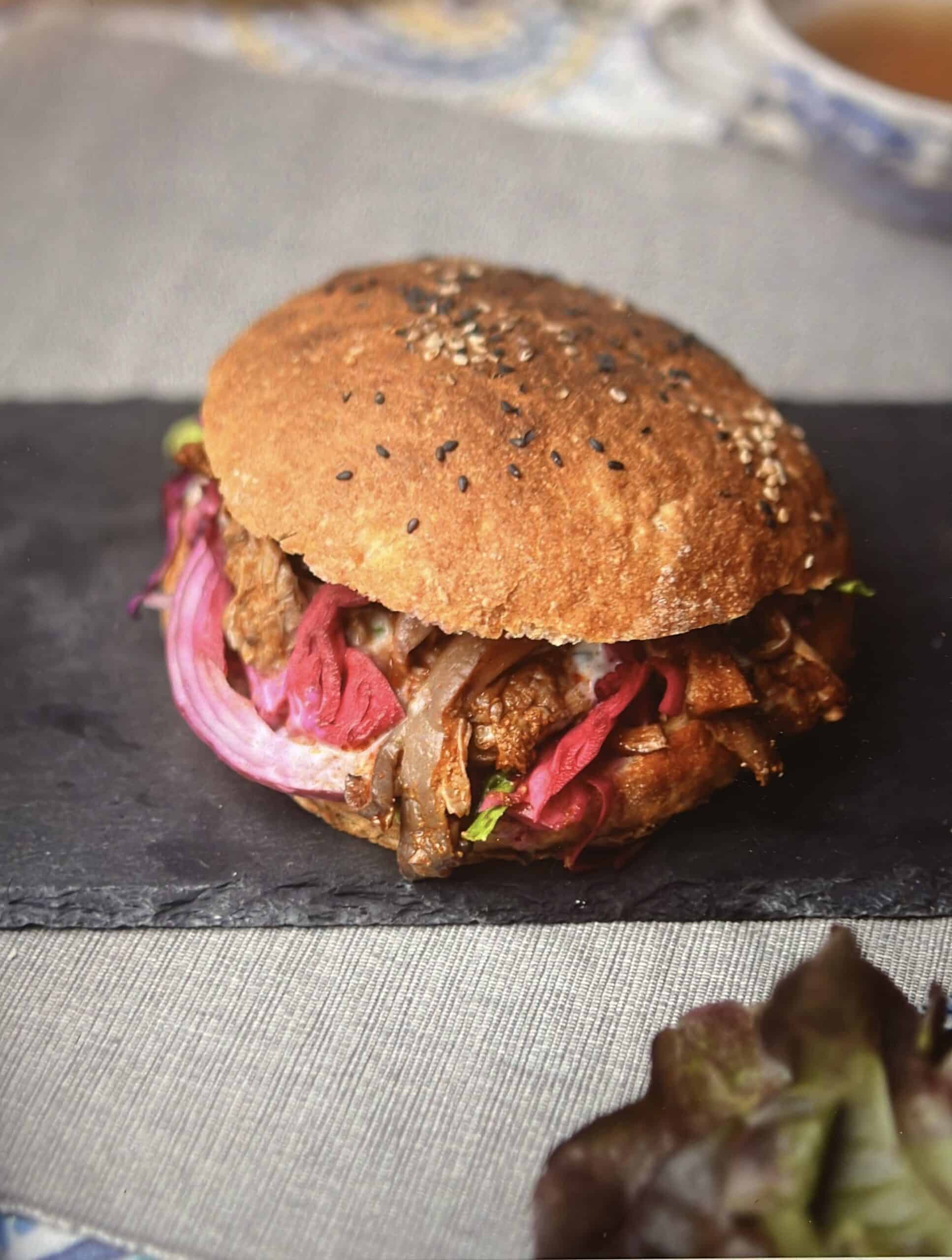
You can cut these rolls open on one side and start stuffing in ingredients of your choice. The classic Döner kebap experience contains lettuce, onion, red cabbage, thin grilled meat slides, and a yogurt sauce. You can easily make a vegan Döner by using soy protein, fake meats, or sliced mushrooms.
Another great variant is filling the döner bread with hummus, falafel, and vegetables.
How to bake Döner bread rolls
Making these döner breads does not take too much of your time. The work time is approximately 15 minutes only. During the remaining hour, the dough will just be resting or baking.
For preparation, you should use a hand mixer. You can knead the dough entirely by hand if you have more time.
The ingredients for Döner bread rolls
Original Pide uses mainly white wheat flour. This recipe replaces a fair amount of the highly processed all-purpose flour with a healthier whole-grain spelt flour. To rise, we use fresh yeast.
- 300g / 1.25 cups whole grain spelt flour
- 200g / 1.6 cups all purpose flour
- 350ml / 1.5 cups water
- 25g / 0.9oz fresh yeast
- 3g / 0.1 oz salt
- 0.5 tsp sugar
- 2 tbsp sesame
Mixing the dough
Take a big bowl and mix the flowers roughly together. Add the fresh yeast, salt, and sugar to the water and stir well to dissolve the yeast entirely. Add water to the flour and mix the dough for around 5 minutes until even. It should be a bit sticky but generally holds together well.

Cover the dough with a towel and let it rest for around 20 minutes at a warm place. This should be enough time to let the dough rise to double the size of its volume.

Forming the bread rolls
After the first fermentation, cover a clean working surface with flour and toss the entire dough onto it. Cover it well with flour from all sides and bring it into a long shape that you can easily divide into four pieces.
Shape the dough ball and add surface tension by bending the dough inside out in one direction. The dough should stretch like a balloon. You can pinch the dough on the backside to close it up properly. Try to avoid any larger cracks on the surface.
Softly press the dough ball into a flat disk, around 3-4cm / 1.5in thick.
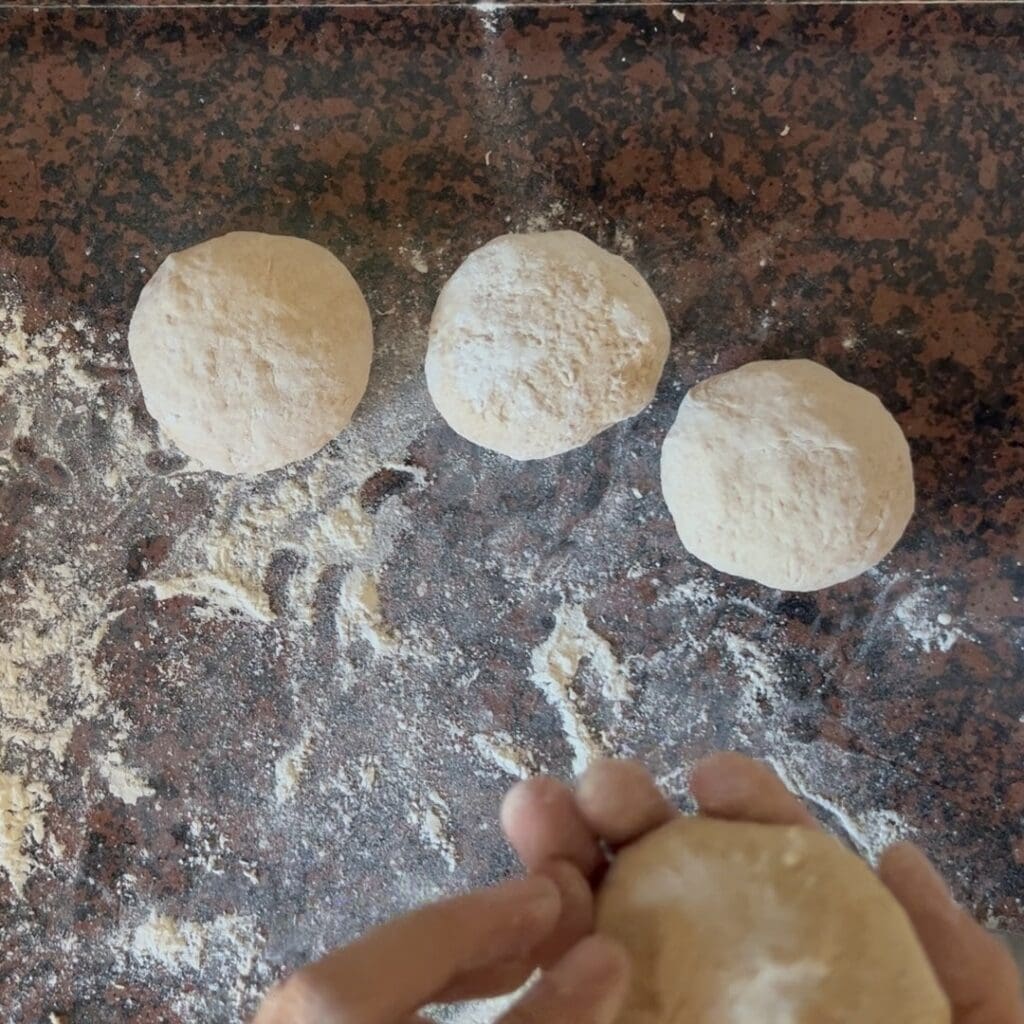
Prepare a baking tray with baking paper and evenly distribute the dough balls onto it. Cover them with a towel and let them rise for another 20 minutes. Ensure enough space between them so they won't meld into one while rising.
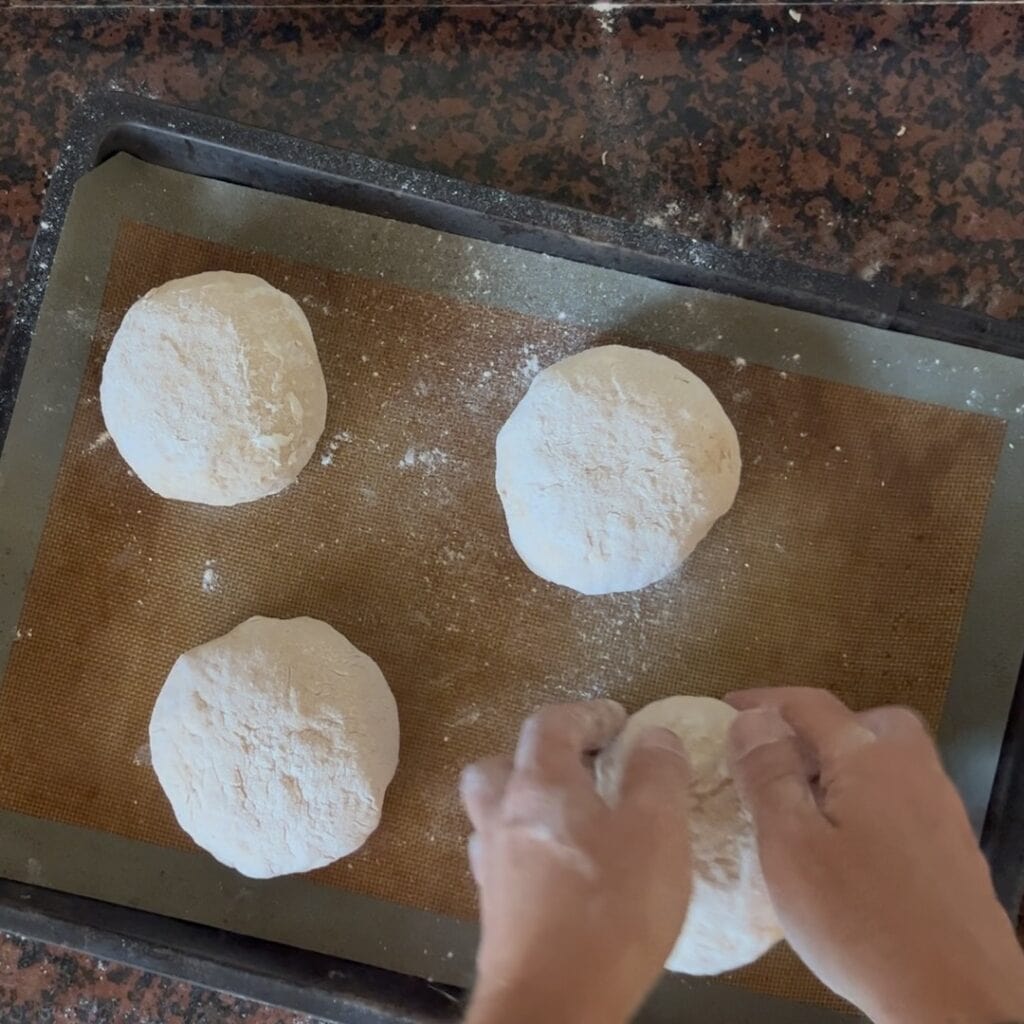
Prepare the wet bake
We will prepare a wet bake to give these Döner bread rolls a decent crust. Preheating can take up to 20 minutes, depending on the oven in use. Wet baking is a technique where the bread is baked in steam.
When baking wet, the steam softens up the surface and creates a thin liquid layer where it can boil. This thin layer later becomes a smooth crust without any major cracks inside. The bread will be audibly crunch when bitten.
Generally speaking, the more dry the dough, the better it can profit from a wet bake. If a dough is already wet, boiling processes can start without extra help. But if the dough is not wet enough, adding steam to the bake is just the trick to get more crust.
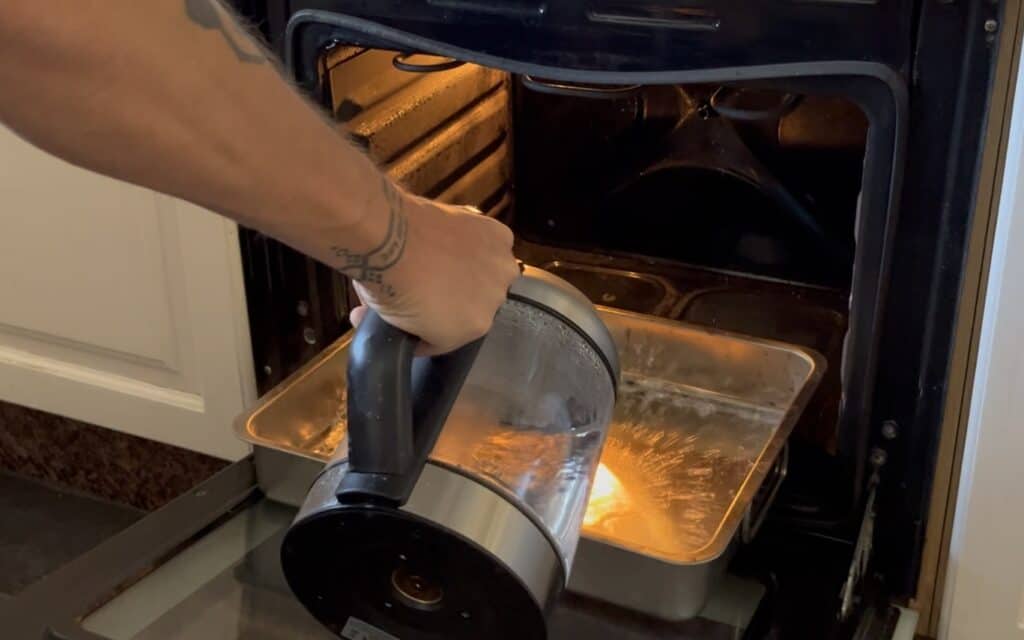
You can make a wet bake in many containers, but adding a container of boiling water below the baking tray is the easiest way for most households. You should use a metal container for the hot water, as glass and porcelain break easily on rapid temperature changes.
Step by step:
- Turn on the oven and set it to 230° C / 450°F
- Place a metal tray at the bottom of the oven.
- Let the oven preheat.
- Meanwhile, bring water to a boil.
- When the oven and water are hot, carefully pour the water onto the tray. Be careful, as the hot water quickly splashes and can cause severe burns.
- When ready, add the baking goods into the oven and let the wet bake begin.
Decorating the Döner bread with sesame
When the dough has risen, brush some water on top of the bread rolls to make it sticky. Be careful not to press the dough too much while doing so. When it's grown it is very fragile and can easily lose it's air.
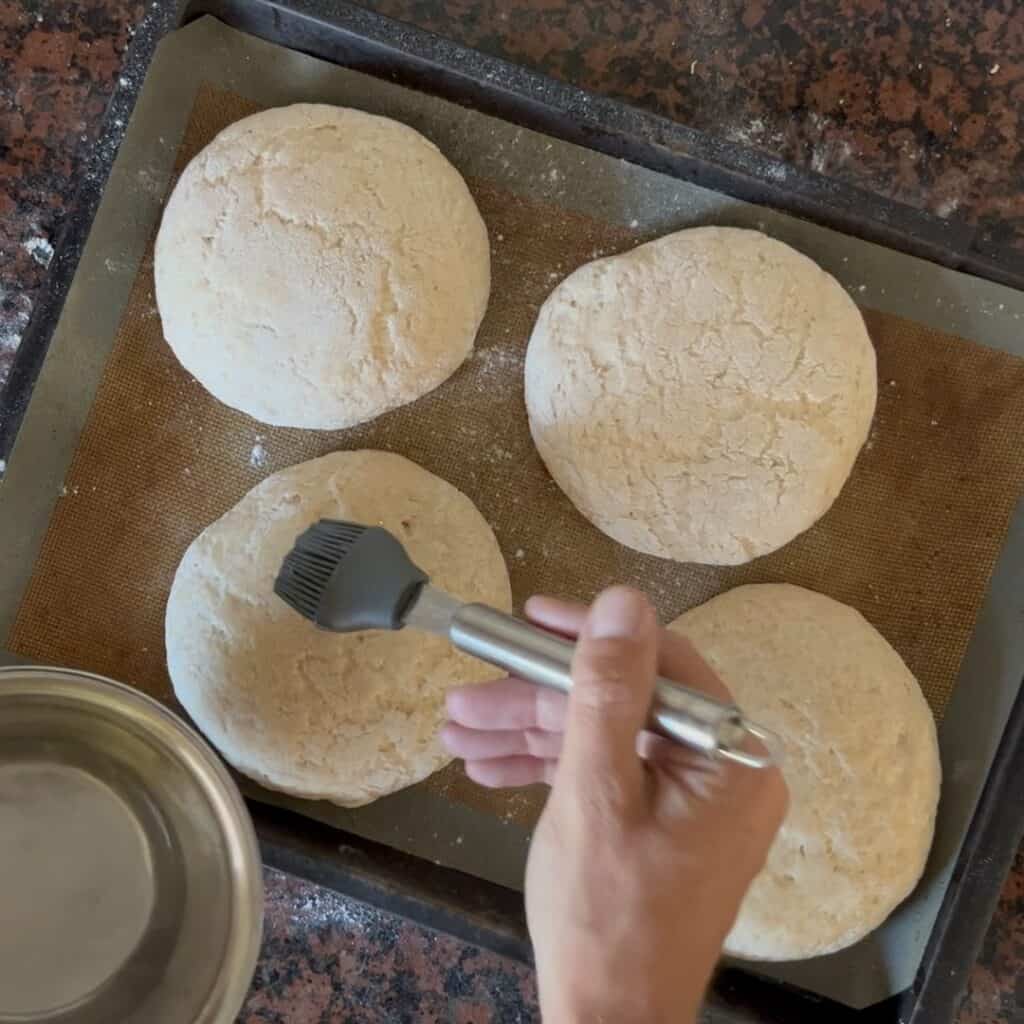
When the dough is wet outside, sprinkle it with sesame seeds. I used both black and white sesame seeds, as seen in the pictures.
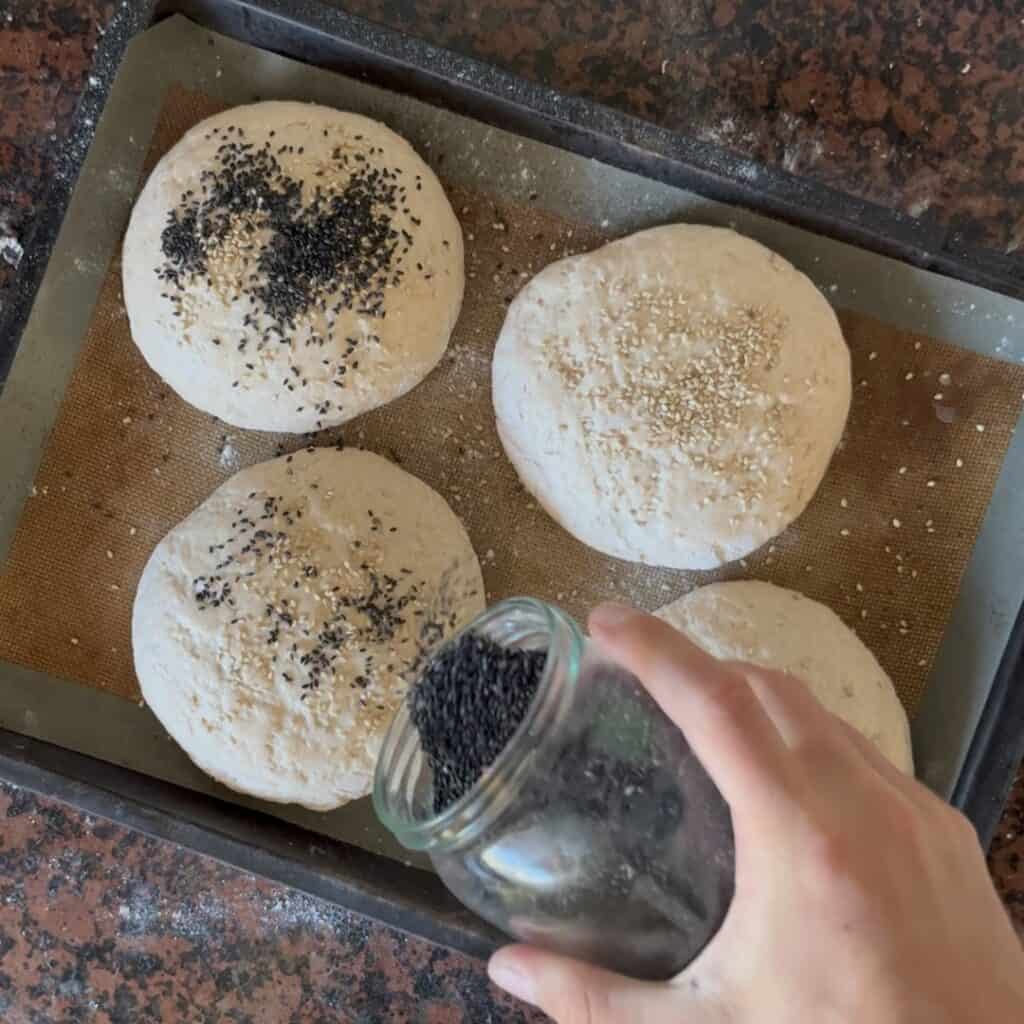
Wet baking the bread rolls
With your oven hot and your dough risen and decorated, we are ready to start the wet bake. Open the door of your oven carefully as hot steam arises. Place the baking tray in the middle. After 13 minutes of baking, they should turn brown and are ready.
Turn off the oven and take out the baked goods. Be careful when opening the door, as hot steam might still rise. Move the bread rolls carefully and lever sticky parts off using a flat spatula. Turn the bread rolls upside down for cooling, releasing more moisture from the soft bottom.

Size variations of this döner bread
The exact amount of dough can also be used differently. You can create one pizza-sized pide bread from it, which you can then later cut into wedges. This will lead you to the classic döner kebap street-style experience.
If you want to create smaller breads, this recipe can also be divided in six smaller rolls.
Making a Turkish flatbread
To make a whole wheel of flatbread, you do not need to separate the dough into smaller pieces. After the first resting phase, knead the dough on a well-floured surface and push it into a disk the size of a pizza. Flour it well from the bottom, transfer it to a pizza tray, and cover up for the second 20 minutes of growing time.
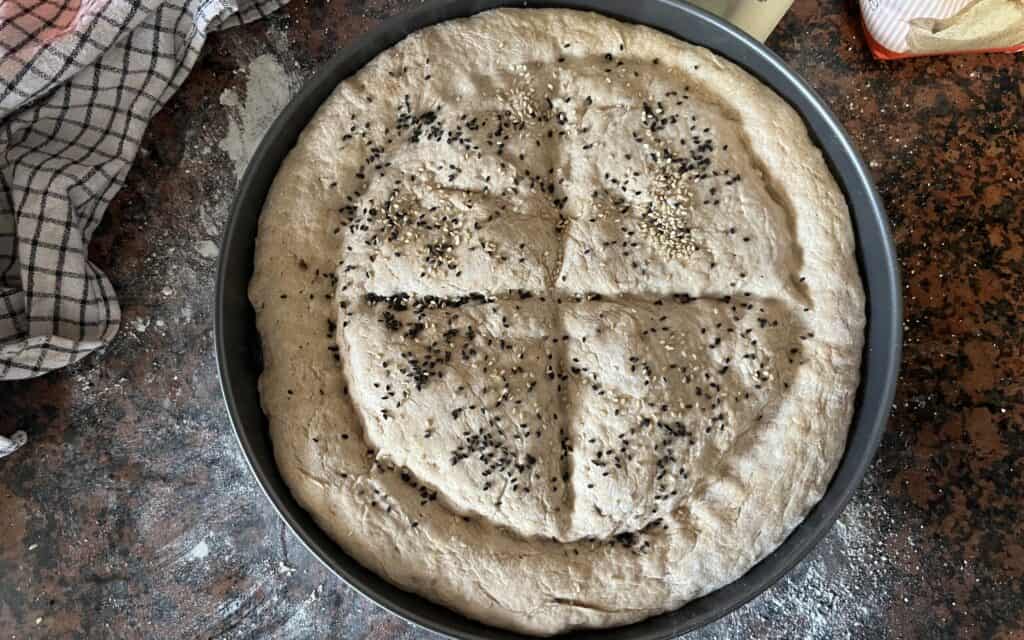
After resting, use your fingers to push in small decorative lines around the border and across the middle of the bread. Paint the surface wet with water and continue decorating as usual.
After the wet bake, you will have one large döner bread, ready to be shared with other people.

6 smaller breadrolls
You can also make breakfast-sized bread rolls out of this dough. For this, cut the entire dough into 6 equal pieces.
From here, go on shaping the dough as usual, but don't press it flat, as you would do following the regular recipe. Decorate the dough to your liking and wet bake for 13 minutes.
Common mistakes that can happen during baking.
Compared to regular cooking, baking is a more sensitive process where many parameters must be matched for a good result. On top of that, the quality of the flour in use can vary heavily around the planet. It may require some intuition and experience to get the dough right.
The breads are small and heavy and not fluffy on the inside.
This most likely means the dough did not rise properly. This can be influenced by multiple factors:
- not enough yeast: if there is too much dough for the yeast to ferment, it won't produce enough gas in the given time to rise the dough properly. Solution: try adding more yeast.
- The yeast is damaged or dead: This can happen if fresh yeast rests in your fridge for too long time. You can also kill it if you used warm water to dissolve the yeast. Solution: make sure the yeast is not behind it's expiry date and smells fresh. Avoid using warm water to dissolve the yeast.
- It's too cold: the fermentation process slows down with a lower room temperature. This can lead to a mediocre rise of the dough. Solution: Give it more time, or move the dough to a warmer place when rising. Ideal are temperatures between 22-25° C or 72-77° F.
The dough is too liquid/sticky or too dry.
If you follow the recipe and its exact metrics and your dough turns out either too liquid or too dry, this points at the quality of the flour you use. After all, each flour is different; it may be that the one you use holds too little (the dough stays liquid) or too much water (the dough gets too firm).
The ideal dough for this döner bread recipe turns out just slightly sticky. It should stick on your fingers if you hold it, but if you pat it or slap it, it should not. You should be able to pick it up with the help of some sprinkles of flour on your hands and not have it running through your fingers.
If you add more bulk to find the right texture, keep the amount of yeast in mind. You might want to add a little more yeast if the volume of the dough changes drastically due to added flour and water.
The dough is too liquid
If the dough contains too much water, it will be very sticky on your hands. A little stickiness is wanted, but if you pat or slap the dough, your hands should stay clean. A too-liquid dough won't stay in shape while resting or baking.
The solution is slowly adding more flour while kneading the dough and watching how the surface develops. Work in more flour gradually until you find a consistency that can be put in shape.
The dough is too firm
A too-dry dough can be easily shaped and stays still in its shape. It does not stick on your fingers at all. This can result in a dough that refuses to rise, and you might get heavy, firm bread after baking. To fix this, incorporate more water into the dough until it becomes fluffy and slightly sticky.
The bread rolls do not stay in shape while resting or baking
For the bread rolls to stay in shape, we need to develop a solid gluten network through proofing (resting) time and proper dough shaping. It can be, that you use too much water (see above), but handling gluten the right way is a tricky task.
It would require a whole article to describe how gluten develops, which I do not have. But I found a great article explaining what happens at the modernist cuisine.
Various reasons might hinder a good gluten network from developing:
- There is not enough gluten present: It may be that the choice of flour results in too low protein and gluten content. To fix that, you can try to swap flours. Go for strong flour instead of all-purpose flour, which contains more gluten, or reduce the whole grain contents and replace it with all-purpose flour.
- The dough did not have enough time to develop gluten: Forming a gluten network takes time. If the dough did not have the chance to develop a proper network, it won't stay in shape. This can easily happen when baking on warm summer days, as the dough might rise faster than usual. This can lead to cutting resting times which affects the gluten development.
- The surface gluten network is not adequately shaped: While it takes just time for a gluten network to form, it must be stretched into its place to stabilize the dough. A well-shaped dough works like a balloon. It has a lot of surface tension on the outside that holds everything together. If your dough doesn't look slick after shaping, it won't hold. This means you should reshape it with more tension.

Döner bread with spelt
Equipment
- Hand mixer optional
Ingredients
- 300 g whole grain spelt flour
- 200 g all purpose flour
- 350 g water
- 25 g fresh yeast
- 3 g salt
- 0,5 tsp sugar
- 2 tbsp sesame
Instructions
Preparing the dough
- Mix the flowers in a large bowl. Crumble the yeast into the water, then add salt and sugar. Stir well to dissolve the yeast completely. Use a hand mixer to knead the dough for around 5 minutes or until even and less sticky.
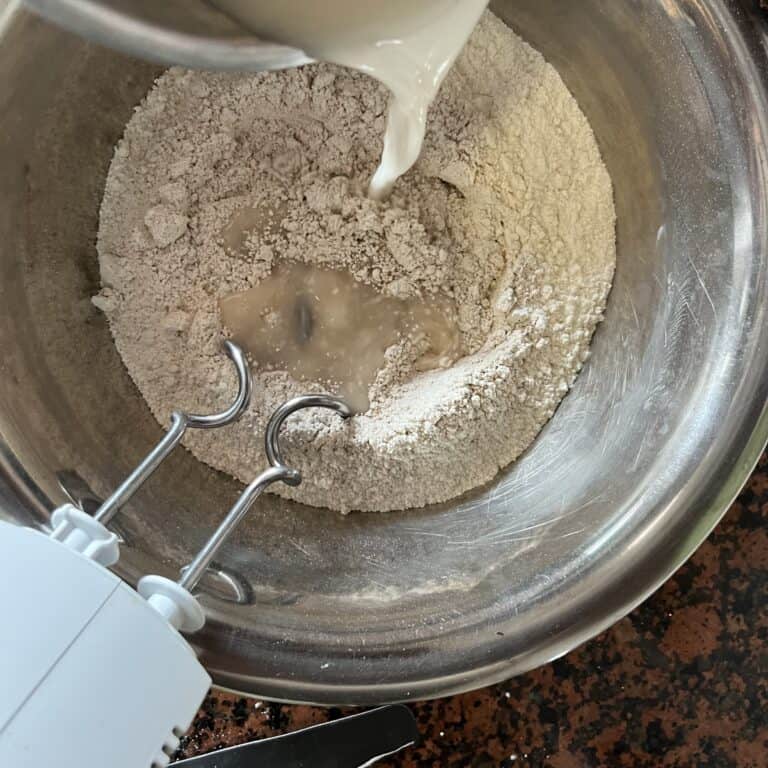
- Cover and put aside for 20 minutes to let the yeast double the volume of the dough.

Forming the bread rolls
- Sprinkle flour on a clean working surface and toss the dough into it. Cover it well with flour from all sides. Cut the dough into four equal-sized pieces. Form a gluten net by bending the dough inside out. Close the end of the dough by pinching it closed. Press between your hands to flatten out a bit.
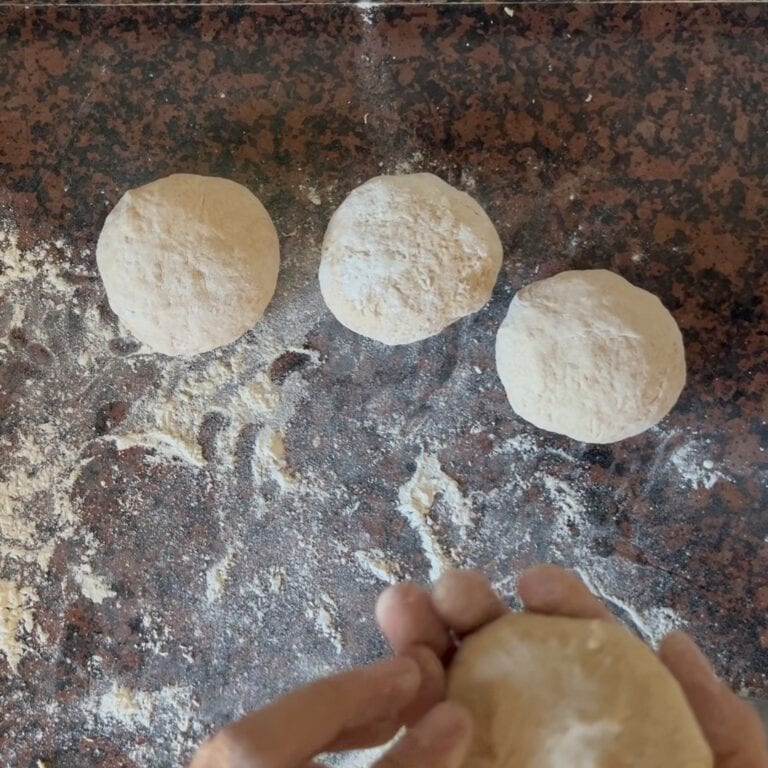
- Flour the dough balls well and place them well apart on a baking tray. Let them rest covered for another 20 minutes.
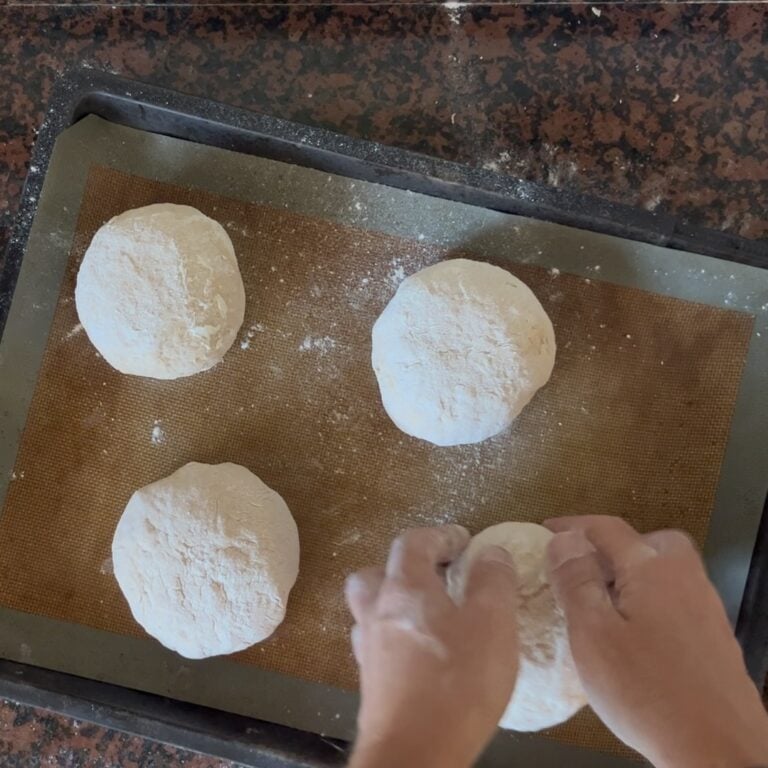
- Paint water onto the grown dough and sprinkle with sesame seeds.
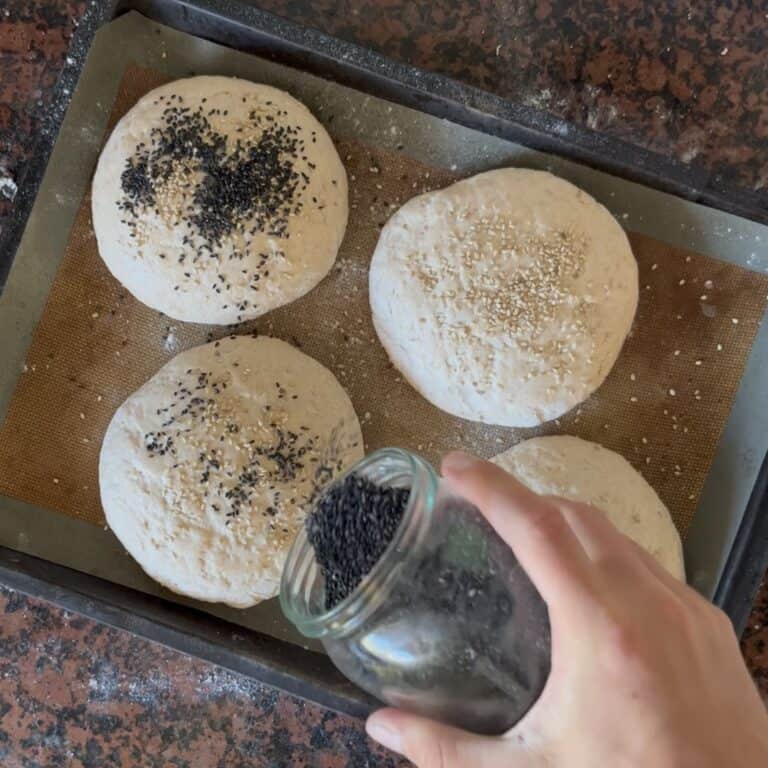
Wet-Baking the bread rolls
- Insert a metal container (plastic-free!) into the bottom of the oven. Preheat at 230°C / 450° F. Meanwhile, bring one liter of water to boil in your kettle. When the oven is hot, add the boiling water to the container. Be careful, as the hot water can splash up high.
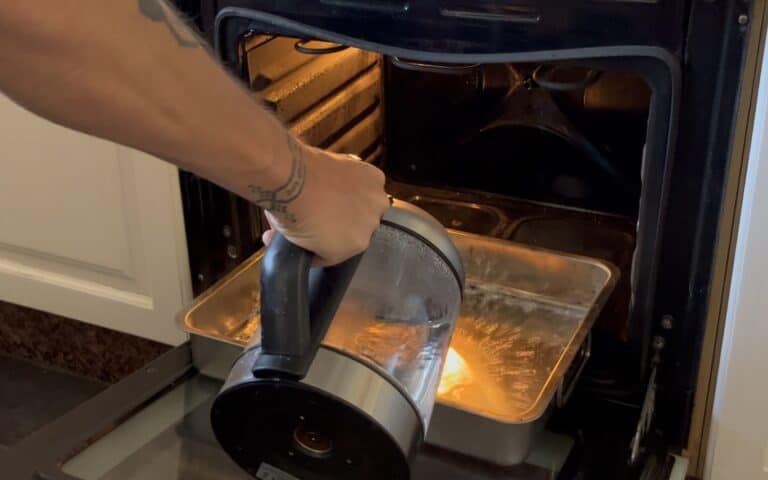
- Add the bread rolls to the oven and bake for 13 minutes or until turning brown.
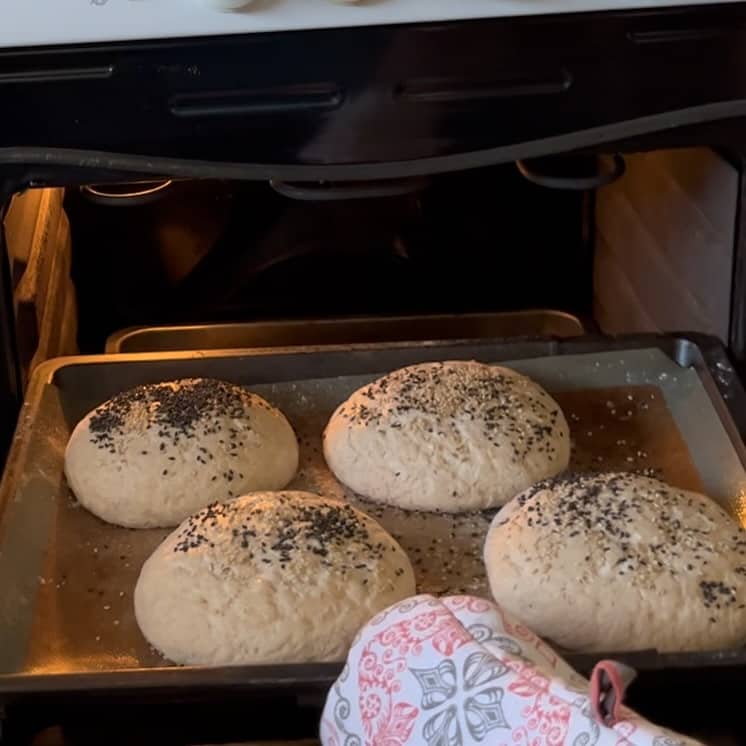
- When well done, let the bread rolls cool down. Turn them upside down so their bottoms won't stick on the tray and can breathe out moisture from below.


Love this recipe? You’ll love my book too!
Learn to cook healthy and flavorful meals from scratch and boost your well-being through nutrition.
Get your copy of “Embracing Change” now.
Notes
Nutrients per serving

